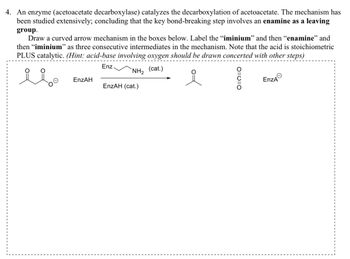
Chemistry
10th Edition
ISBN: 9781305957404
Author: Steven S. Zumdahl, Susan A. Zumdahl, Donald J. DeCoste
Publisher: Cengage Learning
expand_more
expand_more
format_list_bulleted
Concept explainers
Question

Transcribed Image Text:4. An enzyme (acetoacetate decarboxylase) catalyzes the decarboxylation of acetoacetate. The mechanism has
been studied extensively; concluding that the key bond-breaking step involves an enamine as a leaving
group.
Draw a curved arrow mechanism in the boxes below. Label the "iminium” and then "enamine" and
then "iminium" as three consecutive intermediates in the mechanism. Note that the acid is stoichiometric
PLUS catalytic. (Hint: acid-base involving oxygen should be drawn concerted with other steps)
Enz
(cat.)
NH2
EnzAH
EnzAH (cat.)
O=U=0
Θ
EnzA
Expert Solution
This question has been solved!
Explore an expertly crafted, step-by-step solution for a thorough understanding of key concepts.
Step by stepSolved in 4 steps with 3 images

Knowledge Booster
Learn more about
Need a deep-dive on the concept behind this application? Look no further. Learn more about this topic, chemistry and related others by exploring similar questions and additional content below.Similar questions
- Refer to the reaction energy diagram to answer parts (a) through (e). (a) What is the rate-limiting STEP? (Select from 1, 2, 3, or 4) (b) The TRANSITION STATE for the fastest step is: (c) In the 3rd step which INTERMEDIATE structurally resembles the transition state according to the Hammon postulate? (d) Which STEP NUMBER is endergonic? (e) The number of intermediates in the overall reaction is:arrow_forwardProvide an arrow pushing mechanism for the following reaction. Include protons and each step clearly indicated. OEt NaOEt, EtOH EtO OEt OEt OEt NaOEt, EtOH then H* work uparrow_forwardOn a scrap piece of paper, draw a curved arrow mechanism for the following reaction. Once you have determined the major organic product, draw it in the space provided below. -Br 1) Ph P 2) n-BuLi 3) Harrow_forward
- 1. Take a close look at the following reactions. (a) Draw the product in the box below. (b) Provide the mechanism in the space below the reaction scheme. H₂O, H₂SO4arrow_forwardUse a scrap piece of paper to draw the curved arrow mechanism for the reaction below. Use your mechanism to help you determine the major organic product formed, then draw it in the space provided.arrow_forwardhelp please answer in text form with proper workings and explanation for each and every part and steps with concept and introduction no AI no copy paste remember answer must be in proper format with all workingarrow_forward
- Synthesise the target molecules drawn below using precursor chemicals within the following limitations: 1) ALL intermediates and reagents must be shown.2) Each molecule requires multiple step synthesis.3) You must also synthesize any organometallic reagents or ligands that you wish to use. a) Aspirin is a common pain killer that was developed by Bayer.arrow_forwardOn a scrap piece of paper, draw the curved arrow mechanism for the preferred reaction pathway of the following reaction. Assume an aqueous workup at the end of the reaction and draw the major organic products in the space provided. O O He NH₂ + Y N.arrow_forwardBha Please don't provide the handwriting solutionarrow_forward
arrow_back_ios
SEE MORE QUESTIONS
arrow_forward_ios
Recommended textbooks for you
 ChemistryChemistryISBN:9781305957404Author:Steven S. Zumdahl, Susan A. Zumdahl, Donald J. DeCostePublisher:Cengage Learning
ChemistryChemistryISBN:9781305957404Author:Steven S. Zumdahl, Susan A. Zumdahl, Donald J. DeCostePublisher:Cengage Learning ChemistryChemistryISBN:9781259911156Author:Raymond Chang Dr., Jason Overby ProfessorPublisher:McGraw-Hill Education
ChemistryChemistryISBN:9781259911156Author:Raymond Chang Dr., Jason Overby ProfessorPublisher:McGraw-Hill Education Principles of Instrumental AnalysisChemistryISBN:9781305577213Author:Douglas A. Skoog, F. James Holler, Stanley R. CrouchPublisher:Cengage Learning
Principles of Instrumental AnalysisChemistryISBN:9781305577213Author:Douglas A. Skoog, F. James Holler, Stanley R. CrouchPublisher:Cengage Learning Organic ChemistryChemistryISBN:9780078021558Author:Janice Gorzynski Smith Dr.Publisher:McGraw-Hill Education
Organic ChemistryChemistryISBN:9780078021558Author:Janice Gorzynski Smith Dr.Publisher:McGraw-Hill Education Chemistry: Principles and ReactionsChemistryISBN:9781305079373Author:William L. Masterton, Cecile N. HurleyPublisher:Cengage Learning
Chemistry: Principles and ReactionsChemistryISBN:9781305079373Author:William L. Masterton, Cecile N. HurleyPublisher:Cengage Learning Elementary Principles of Chemical Processes, Bind...ChemistryISBN:9781118431221Author:Richard M. Felder, Ronald W. Rousseau, Lisa G. BullardPublisher:WILEY
Elementary Principles of Chemical Processes, Bind...ChemistryISBN:9781118431221Author:Richard M. Felder, Ronald W. Rousseau, Lisa G. BullardPublisher:WILEY

Chemistry
Chemistry
ISBN:9781305957404
Author:Steven S. Zumdahl, Susan A. Zumdahl, Donald J. DeCoste
Publisher:Cengage Learning

Chemistry
Chemistry
ISBN:9781259911156
Author:Raymond Chang Dr., Jason Overby Professor
Publisher:McGraw-Hill Education

Principles of Instrumental Analysis
Chemistry
ISBN:9781305577213
Author:Douglas A. Skoog, F. James Holler, Stanley R. Crouch
Publisher:Cengage Learning

Organic Chemistry
Chemistry
ISBN:9780078021558
Author:Janice Gorzynski Smith Dr.
Publisher:McGraw-Hill Education

Chemistry: Principles and Reactions
Chemistry
ISBN:9781305079373
Author:William L. Masterton, Cecile N. Hurley
Publisher:Cengage Learning

Elementary Principles of Chemical Processes, Bind...
Chemistry
ISBN:9781118431221
Author:Richard M. Felder, Ronald W. Rousseau, Lisa G. Bullard
Publisher:WILEY